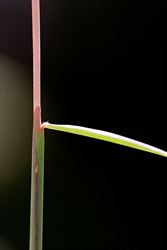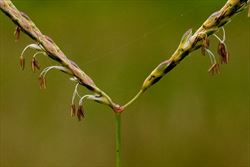Batiki blue grass; it is also known as Indian murainagrass, or smut grass. The last name is presumably because of susceptibility to the smut, Sphacelotheca ischaemicola, in Asia and Papua New Guinea, which attacks the inflorescence.
Pacific Pests, Pathogens, Weeds & Pesticides - Online edition
Pacific Pests, Pathogens, Weeds & Pesticides
Batiki blue grass (511)
Polytrias indica. Previously, it was known as Ischaemum indicum, among many other synonyms. It is a member of the Poaceae. Note, Flora of China states: "This grass has been widely known as Ischaemum indicum (Houttuyn) Merrill (Phleum indicum Houttuyn), but that name in fact refers to a species of Polytrias". Kew (Plants of the World Online) accepts Polytrias indica as the correct name with Ischaemum indicum as a synonym. However, the identity of the plants in Pacific island countries is not clear. Australia is a likely source of the grass for those countries where Ischaemum indicum is presumed to be present but, in Australia, collections have been identified as Ischaemum indicum and also Ischaemum tropicum. Under the circumstances, it is best if specimens are collected from Pacific island countries and re-dentified by a grass taxonomist.
The images are all from WIKTROP as Ischaemum ciliare Retz.The website lists several Ischaemum indicum varieties as synonyms. The Royal Botanic Gardens Kew, Plants of the World Online also list Ischeamum indicum as a synonym of Polytrias indica (Houtt.) Veldkamp.(https://powo.science.kew.org/taxon/urn:lsid:ipni.org:names:963150-1). POWO (2022). Plants of the World Online. Facilitated by the Royal Botanic Gardens, Kew. (http://www.plantsoftheworldonline.org/).
Asia, Africa (West), North (Hawaii), South and Central America, Oceania. It is recorded from Fiji, Federated States of Micronesia, French Polynesia, Niue, Papua New Guinea, Samoa, Solomon Islands, and Wallis and Futuna. It is native to South and Southeast Asia.
A perennial grass invading open or disturbed habitats, forming dense mats in pastures, cultivated crops, openings in forests, along roadsides, ditches and on hillsides. Adapted to a range of soil types (acid soils, and soils of poor fertility), high rainfall (up to 7000 mm per year), with tolerance to waterlogging, moderate tolerance to shade, but not drought tolerant. Mostly coastal to 600 masl. Its invasiveness is attributed to rapid spread from cuttings in disturbed ground and forest clearings outcompeting other weeds, crop plants and native species.
Stems, erect or lying near the ground, up to 90 cm, develop from long stolons. Leaves up to 30 cm long, covered in fine, soft hairs (heavier on the sheaths), sometimes with red-purple margins, and tapering to a point. The ligule (the membrane between leaf and stem) is 1-2 mm long. Flowers (spikelets) arranged along stalks (single or paired), purplish, triangular, up to 10 cm long. The spikelets are about 5 mm long, paired, one has a stalk the other not, alternating on one side of the stalk. Each has an awn, 8-15 mm long. Roots form from the lowers nodes on the stems.
Seed, and locally by root developing from nodes on stolon pieces. Greatest spread has probably been intentional as the grass has been used widely in the tropics as a pasture species.
Direct impacts of batiki blue are, for example, a weed of turf grasses in Malaysia, and a weed of pineapple in south India. However, in neither of these situations were economic analyses presented. Environmental impacts result from its rapid development of stolons forming vegetative mats with the potential to smother native vegetation. Indirect impacts result from it being an alternate host of rice diseases (e.g., sheath blight caused by Rhizoctonia solani), but not as an alternative host of rice tungro associated viruses.
A useful pasture species in Southeast Asia and the Pacific islands, as well as a lawn (turf) grass. It also finds use as a ground cover and to prevent soil erosion. Experimentally, it has been found to be an adequate silage if additions of molasses, corn and citrus pulp are made. As a pasture grass, it can be heavily grazed, and is competitive, with fast-growing stolons resisting weed invasions; however, it does have limitations: lower production occurs during cooler months; it may taint milk; and lower productivity occurs when grown with tree crops.
BIOSECURITY
The distribution of Ischaemum indicum is likely to be greater than published lists. The grass has been distributed widely as a pasture species. Nevertheless, those countries yet free from the grass should consider its invasiveness. Particular attention should be given to the possibility that its seed may contaminate that of other imported (pasture) species.
BIOLOGICAL CONTROL
No information available.
CULTURAL CONTROL
- Physical & Mechanical:
- Hand weeding (and hoeing) is effective on small areas where follow-up is possible to control seedlings.
- Slashing will slow growth, but not prevent it; note, stems pieces will root and form new plants readily. Pieces may be spread in the cloven hooves of cattle, pigs, goats, sheep, etc.
- Hygiene:
- Treat vehicles and farm machinery. If moving from areas where the weed occurs to those weed-free, wash to remove soil and seed. This is equally important if the machinery is being imported into a country or moved within a country.
CHEMICAL CONTROL
IRRI lists thiobencarb, pendimethalin, and mixtures of thiobencarb and propanil, among others for the control of the related Ischaemum rugosum in rice. In Fiji, glyphosate.
--------------------
Note, EU approval to use glyphosate was to end in December 2022, but has been extended till 15 December 2023; its use after that date is under discussion.
____________________
When using a pesticide, always wear protective clothing and follow the instructions on the product label, such as dosage, timing of application, and pre-harvest interval. Recommendations will vary with the crop and system of cultivation. Expert advice on the most appropriate herbicides to use should alway
AUTHORS Grahame Jackson & Makereta Ranadi
Information from Ischaemum ciliare. Tropical forages. (https://www.tropicalforages.info/text/entities/ischaemum_ciliare.htm); and Giruja T, MV Menon (2019) Diversity of weed flora in pineapple plantations of Kerala Journal of Crop and Weed 15(1): 218-221. (https://www.cropandweed.com/archives/2019/vol15issue1/15-1-37.pdf); and Juraimi AS et al. (2008) Floristic Composition of Weed Community in Turf Grass Area of West Peninsular Malaysia. International Journal of Agriculture and Biology 11(1). (https://www.researchgate.net/publication/242083402_Floristic_Composition_of_Weed_Community_in_Turf_Grass_Area_of_West_Peninsular_Malaysia); and Flora of China (2006). Volume 22: 609-619. (http://flora.huh.harvard.edu/china/PDF/PDF22/Ischaemum.pdf); and Khan MA, et al. (1991) Rice hosts of rice tungro-associated viruses and leafhopper vectors. Plant Disease 75(9): 926-930. (https://www.apsnet.org/publications/PlantDisease/BackIssues/Documents/1991Articles/PlantDisease75n09_926.PDF); and Ischaemum ciliare (PROSEA). Pl@ntUse. Plant Resources of South-East Asia. (https://uses.plantnet-project.org/en/Ischaemum_ciliare_(PROSEA); and Ischaemum rugosum Salib. Rice Knowledge Bank. IRRI. (http://www.knowledgebank.irri.org/training/fact-sheets/item/ischaemum-rugosum-salisb); and from Ischaemum ciliare Retz., Poaceae. Pacific island ecosystems at risk (PIER). (http://www.hear.org/pier/species/ischaemum_ciliare.htm). Photo 1-4 Ischaemum ciliare Retz. WIKTROP - Weed identification and knowledge in the tropical and Mediterranean areas. (https://portal.wiktrop.org/species/show/801). Photo 5 POWO (2022). Plants of the World Online. Facilitated by the Royal Botanic Gardens, Kew. (https://powo.science.kew.org/taxon/urn:lsid:ipni.org:names:963150-1).
Produced with support from the Australian Centre for International Agricultural Research under project HORT/2016/185: Responding to emerging pest and disease threats to horticulture in the Pacific islands, implemented by the University of Queensland, in association with the Pacific Community and Koronivia Research Station, Ministry of Agriculture, Fiji.








